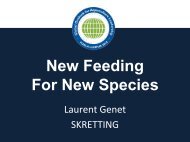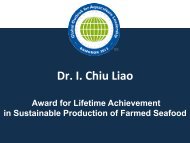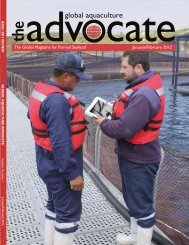May/June 2010 - Global Aquaculture Alliance
May/June 2010 - Global Aquaculture Alliance
May/June 2010 - Global Aquaculture Alliance
You also want an ePaper? Increase the reach of your titles
YUMPU automatically turns print PDFs into web optimized ePapers that Google loves.
global aquaculture<br />
the<br />
e som thing<br />
n w<br />
NOW... read each issue<br />
of the Advocate in<br />
electronic form at<br />
www.gaalliance.org.<br />
It’s informative. It’s easy.<br />
And it’s free!<br />
Most aquaculture exhibits LCA assessments lower than those for other farm-raised<br />
protein industries.<br />
Table 1. Carbon emission values for common aquaculture species.<br />
Salmon<br />
Shrimp<br />
Product<br />
Tilapia<br />
Carp in RAS<br />
Mussels<br />
kg Carbon<br />
Dioxide/kg<br />
3.40<br />
11.10<br />
1.67<br />
0.80<br />
0.01<br />
Country Product<br />
Denmark<br />
Belgium<br />
Sweden<br />
Denmark<br />
Belgium<br />
Sweden<br />
Denmark<br />
Belgium<br />
Sweden<br />
Belgium<br />
United Kingdom<br />
United Kingdom<br />
Beef<br />
Beef<br />
Beef<br />
Pork<br />
Pork<br />
Pork<br />
Chicken<br />
Chicken<br />
Chicken<br />
Lamb<br />
Seafood (average of 10 products)<br />
Farmed salmon<br />
inputs are zero, so the species have minimal<br />
carbon emissions from their growing<br />
and harvesting.<br />
Protein Comparisons<br />
Carbon footprint assessments of various<br />
farmed seafood compare well to those<br />
of other protein sources. In Sweden,<br />
Skretting found that beef production<br />
“cost” about 14 kg carbon dioxide per kg<br />
of edible meat. Pork came in with a rating<br />
of about 4.8 kg carbon dioxide/kg.<br />
Chicken rated 1.9 kg – just below the 2.0<br />
Standard<br />
Deviation Source<br />
1.1<br />
3.3<br />
0<br />
0<br />
0<br />
Ayer and Tyedmers, 2009<br />
Mungkung and Gheewala, 2007<br />
Friend of the Sea, Seafish<br />
Mungkung, 2005<br />
Sun, 2009<br />
Friend of the Sea<br />
Troell et al., 2004<br />
Friend of the Sea<br />
Thane<br />
Table 2. Carbon emission values for protein<br />
sources in different countries.<br />
*Swedish Institute for Food and Biotechnology<br />
kg Carbon<br />
Dioxide/ kg Source<br />
22.50<br />
34.00<br />
14.00<br />
3.98<br />
11.00<br />
5.00<br />
3.10<br />
7.00<br />
1.80<br />
50.00<br />
6.10<br />
1.70<br />
Weidema, 2003<br />
Nemry et al., 2001<br />
SIK*<br />
Weidema<br />
Nemry<br />
SIK*<br />
Weidema<br />
Nemry<br />
SIK*<br />
Nemry<br />
Davies, 2009<br />
Davies, 2009<br />
kg carbon dioxide/kg meat mark for<br />
salmon.<br />
Both Denmark and Belgium have<br />
studied the impacts of their meat industries,<br />
as shown in Table 2. The average<br />
carbon dioxide footprint of the top 10<br />
retail seafood species in the United Kingdom<br />
is included for comparison. <strong>Aquaculture</strong><br />
is generally much more efficient<br />
than beef and lamb production, and<br />
modern salmon farming, rated better<br />
than even chicken farming, has the lowest<br />
carbon value.<br />
innovation<br />
Biofloc: Novel Sustainable<br />
Ingredient For Shrimp Feed<br />
A researcher at Virginia Tech investigates the condition of a shrimp during<br />
an experimental trial.<br />
Summary:<br />
Recent research is demonstrating<br />
that biofloc-based proteins are<br />
suitable replacements for fishmeal<br />
in aquaculture diets. Since<br />
bioflocs can be produced while<br />
treating aquaculture effluents, a<br />
waste product can be converted<br />
into a valuable resource. Work<br />
by the authors found that shrimp<br />
fed diets with bioflocs grew faster<br />
than similar shrimp fed fishmealbased<br />
feed. Potential also exists<br />
for the production of bioflocs<br />
with targeted nutrient levels by<br />
manipulating production factors.<br />
Shrimp farming has traditionally<br />
relied on fishmeal for the formulation of<br />
nutritionally complete diets. However,<br />
fishmeal is becoming more expensive,<br />
and natural fisheries are being overexploited<br />
due to an increase in demand as<br />
the global human population continues to<br />
grow. This is prompting the aquaculture<br />
industry to investigate and implement<br />
alternative sources of protein to replace<br />
less-sustainable protein ingredients for<br />
aquaculture feeds.<br />
Traditional alternative proteins, such<br />
as soybean meal, are derived from plants.<br />
Recent developments in research are demonstrating<br />
that yeast-based and bioflocbased<br />
proteins are also suitable replacements<br />
for fishmeal in aquaculture diets.<br />
Since bioflocs can be produced while<br />
treating aquaculture effluents, bioflocs<br />
may have an additional advantage over<br />
plant-based proteins. This is because a<br />
waste is effectively converted into a valuable<br />
resource for the industry.<br />
Producing Bioflocs<br />
Effluents from aquaculture facilities<br />
can be treated by implementing suspended-growth<br />
biological reactors. These<br />
bioreactors remove nutrients like nitrogen<br />
from the effluent water as bioflocs are<br />
produced. The water is essentially<br />
“cleaned” as bioflocs are produced.<br />
Two major types of bioreactors have<br />
been studied in the authors’ laboratories<br />
for treating aquacultural effluents:<br />
sequencing batch reactors (SBR) and<br />
membrane batch reactors (MBR). A<br />
more detailed description of these pro-<br />
David D. Kuhn, Ph.D.<br />
Civil and Environmental Engineer<br />
Food Science and Technology<br />
Department<br />
FST Building (0418)<br />
Virginia Tech<br />
Blacksburg, Virginia 24061<br />
davekuhn@vt.edu<br />
George J. Flick, Jr., Ph.D.<br />
Gregory D. Boardman, Ph.D.<br />
Food Science and Technology<br />
Department<br />
Virginia Tech<br />
Addison L. Lawrence, Ph.D.<br />
Texas A & M University -<br />
Corpus Christi<br />
Corpus Christi, Texas, USA<br />
cesses is provided in “Suspended-Growth<br />
Biological Processes Clean RAS Wastewater”<br />
in the January/February <strong>Global</strong><br />
<strong>Aquaculture</strong> Advocate.<br />
Nutritional Composition<br />
Biofloc nutritional composition can<br />
vary extensively, but is based on factors<br />
such as effluent characteristics and how a<br />
bioreactor is operated. For example, if two<br />
bioreactors were operated in the same way,<br />
but one received effluent with a high<br />
nitrogen load and the other received effluent<br />
with a low nitrogen load, the bioreactor<br />
receiving the higher load would likely<br />
produce a biofloc with higher levels of<br />
protein than the other bioreactor.<br />
Research evaluating factors that influence<br />
nutritional properties are currently<br />
under way to optimize the nutritional<br />
value (levels of essential amino acids, fatty<br />
acids, proteins and crude fat) of the biofloc<br />
produced.<br />
In studies with SBR and MBR reactors,<br />
the following ranges of dry-matter<br />
nutritional values have been observed:<br />
crude protein, 35 to 49%; carbohydrates,<br />
22 to 36%; crude fiber, 13 to 18%; total<br />
ash, 12 to 28%; and crude fat, 0 to 1%.<br />
In reference to amino acids, nonessential<br />
amino acids can be synthesized<br />
by shrimp. However, the essential or<br />
indispensible amino acids cannot be synthesized<br />
by shrimp. The essential amino<br />
acids in a high-quality shrimp feed and<br />
biofloc typical in the authors’ studies are<br />
compared in Figure 1.<br />
Overall, the levels of essential amino<br />
acids for shrimp compare well, but there is<br />
a notable difference (≥ 0.5%, dry-weight<br />
basis) in the compositions of leucine, lysine<br />
74 <strong>May</strong>/<strong>June</strong> <strong>2010</strong> global aquaculture advocate global aquaculture advocate <strong>May</strong>/<strong>June</strong> <strong>2010</strong> 75





